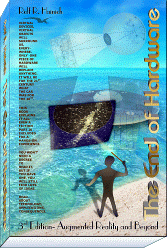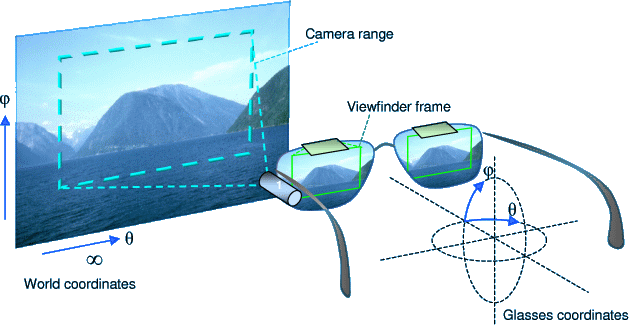Augmented Reality is more than Virtual Reality
Infinity is simple !
The computing power of current mobile devices is not a bottleneck anymore (click here, for an example, although not exactly what we are talking about). What we need to support those current mobile-phone 'AR' apps, is nothing but fixed-focus glasses, showing everything at virtual infinity (and a software adaptation, of course). This is easily achieved, and there isn't any 3D rendering involved:
As we have seen with head-up displays, an image at virtual infinity means pixel positions on the display are converted to angles, and any lateral displacement of the display unit does not change the angular positions of the displayed objects (this is the same effect making the moon appear to follow us if we drive in a car). This principle, called 'collimated display', is also used for the panoramic displays in professional flight simulators.
With headup displays, aiming is possible by pointing the entire plane. A virtual center mark at infinity shown by the headup display will always stay aligned, regardless of the head position of the pilot.
With display glasses, a virtual image at infinity also does not change it's position if the display glasses are changing lateral position or distance to the eye, as any image pixel has only one property: it's angle. Only tilting of the display glasses can change the angular image position.
This configuration requires display glasses with large exit pupils, hence laser scanners are not ideal for this concept. A proper optical construction, keeping the ideal parallelity of the exit beams for a large exit volume, is also required. One technology naturally delivering virtual images at infinity is the q-sight display by BAE Systems. Another solution may be the simple one-mirror glasses construction with a geometry corrected display chip.
A viewfinder frame for a camera fixed to the glasses for example, will stay properly aligned for any distant motives regardless of proper 'fitting' of the glasses.
Projected information can be perfectly aligned to distant objects, requiring only the location and angular direction of the glasses themselves to be known.
For near objects, the alignment is lost of course, and corrections have to be applied.Which implies it does not support Augmented Reality for real -
no nearby objects, no virtual devices, no mask display, no dynamic focusing and so on, all of which still requires eye trackers and other add-ons.For the 'AR' applications that recently became popular with smart phones however, this concept is perfectly sufficient and can be implemented quite simply. While display phones add information to camera pictures shown on a screen, display glasses overlay information directly to the user's sight, a considerable advantage. We would nevertheless wish for an eye tracker, at least allowing for eye-steering - hands-free operation that is -, one of the basic requirements for a really useful device.
Optics designContrary to common opinion, achieving high resolution with a single free-form mirror is not a major problem. Current approaches always try to optimize resolution as well as geometric distortion For a single mirror design, slightly less than VGA resolution has been demonstrated, together with acceptable geometric linearity [103].
Optics design here has to take into account that for any given pixel px on the display, there is a certain eye rotation when the user looks at it, and a corresponding, small area on the mirror, only of the same the size as the user's pupil, which exclusively provides the focusing for that pixel. This assumption is particularly sufficient as a model because the human eye can see sharp only at a small angle in the center of view. Starting from any single pixel, we can then give the mirror a curvature providing exactly the right focus for that pixel, then continue the mirror shape by according curvatures for the neighboring pixels, until we have the entire form. We have meanwhile implemented an algorithm of this type and applied it to AR display designs, together with new ideas approaches like curved and translucent displays. Read the news on this siteAdaptation
Despite all possible simplifications, dynamic fit and focus adaptation will be important for really versatile AR displays, and there are several promising technologies for it. For instance, have a look at these materials about artificial muscles.
home news order
Copyright © 2006-2011 Rolf R. Hainich; all materials on this website are copyrighted.
Disclaimer: All proprietary names and product names mentioned are trademarks or registered trademarks of their respective owners. We do not imply that any of the technologies or ideas described or mentioned herein are free of patent or other rights of ourselves or others. We do also not take any responsibility or guarantee for the correctness or legal status of any information in this book or this website or any documents or links mentioned herein and do not encourage or recommend any use of it. You may use the information presented herein at your own risk and responsibility only. To the best of our knowledge and belief no trademark or copyright infringement exists in these materials. In the fiction part of the book, the sketches, and anything printed in special typefaces, names, companies, cities, and countries are used fictitiously for the purpose of illustrating examples, and any resemblance to actual persons, living or dead, organizations, business establishments, events, or locales is entirely coincidental. If you have any questions or objections, please contact us immediately. "We" in all above terms comprises the publisher as well as the author. If you intend to use any of the ideas mentioned in the book or this website, please do your own research and patent research and contact the author.




